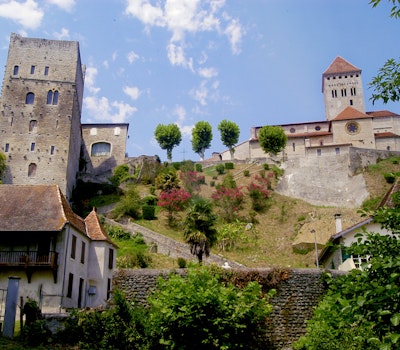Béarn
Together with the Basque Country, the Béarn forms the department of ‘Pyrénées-Atlantiques’. Despite the Béarn being a part of France, this region used to be politically independent from the former French kingdom. This changed when Henry IV of France (whose birthplace is Pau, the capital of the Béarn) became king.
With a height difference of 3000 metres between the lowest point and the highest point, the Béarn has a very diverse environment, with as many different views and a particularly mild climate.
Below is a description of several villages and towns located around Domaine d’Esperbasque and Salies de Béarn in order of distance.
Sauveterre de Béarn
Sauveterre de Béarn is a village south of Salies de Béarn on the border of the Béarn and the Basque Country, beautifully situated above the ‘Gave d’Oloron’, overlooking the Pyrenees.
In the past Sauveterre was strengthened by the nobles of the Béarn. Step into the magical era of the fortifications with nobles such as Gaston VII and Gaston Fébus, who made the Béarn a sovereign state.
Upstream you will find ‘Château de Laàs’ and downstream ‘Sorde l’Abbaye’: an impressive abbey.
Orthez
Orthez is a city with history. As the capital of Gaston Fébus in medieval times, it provides a historical legacy, which shows the prosperity of the past. The “Pont Vieux ”, the emblem of the city, is a passage for the pilgrims of St Jacques de Compostella and the Château Moncade has an unforgettable view over the roofs of Orthez and, weather permitting, the Pyrenees.
Laàs
Between Sauveterre de Béarn and Navarrenx, along the banks of the ‘Gave d’Oloron’ and surrounded by beautiful gardens, you will find the ‘Château de Laàs’.
This castle was built in the 17th century and is situated in a 12 hectare park. It houses one of the finest collections of decorative arts of the Aquitaine region.
A large park with old trees, French garden, rose garden, exotic bamboo forest and a terrace overlooking the ‘Gave d’Oloron’, all contribute to the magic of the place … Your walk continues in the orchard, where old varieties of apple, peach and plum trees have been planted…
Enjoy the castle, the gardens and even take a dip in the river ‘Gave d’Oloron’.
Navarrenx
In the heart of the “Béarn des Gaves’, hidden amongst the hills lies Navarrenx, the oldest fortified village in France.
This village is situated in a quiet area, the variation of the landscape is reflected in the sparkling waters of the ‘Gave d’Oloron’.
Go dream on the old ramparts of Navarrenx or follow the footsteps of the pilgrims of St. Jacques to ‘Château de Mongaston’. Follow the water to the basins of Audaux or Préchacq, in the shade of the beautiful houses. Discover the architecture of the Béarn: brown coloured angled roofs with ochre toned walls and brown shutters.
Pau
Pau is the capital of the Béarn and is known for the ‘Château de Pau’ birthplace of Henry IV. A medieval fortress, a Renaissance castle, a royal residence, a large museum an all in one building where many visitors jostle to view Henry IV’s cradle made out of a giant turtle shell.
Pau is an attractive city that focuses on tourism and sports, especially basketball, rugby and horse riding.
Pau is famous for one of the best views in France: from the ‘Boulevard des Pyrénées’ almost the entire mountain range can be seen. Many writers, painters and poets took it as their inspiration for their masterpieces.
Oloron Sainte Marie
Oloron is a city with a rich history. The history of Oloron goes back to the first century. The Romans created a city ‘Iluro’ alongside the river. They chose this location because of the route along the col du Somport: an important passage to Spain. A chapel was built ‘Chapelle de Sainte Marie’ (the current location of the cathedral Sainte Marie built in the 12th century) and a citadel called ‘Sainte-Croix d’Oloron’ was built on a mound to offer protection.
In the Middle Ages the history of Iluro was forgotten, but because of its strategic location and the presence of the two rivers they started building Oloron in 1080 on and around the former Roman fortification (mound). At the same time Iluro was rebuilt and was given the name of the chapel ‘Sainte Marie’.
Around 1350 there was a clear separation between the two cities: Oloron “Viscount city” and Sainte Marie “Bishop city.” Sainte Marie remained economically highly dependent on Oloron. Until the 15th century Oloron was the economic capital of the Béarn (trade with Spain and textile crafts).
The merge of the two cities to the current Oloron Sainte Marie was in the late 1800s under Napoleon III, it was necessary for the construction of railways and the industrialization of the area.
The cathedral of Oloron Sainte Marie is on the UNESCO World Heritage Sites list.
Pyrenees
In the most southern part of the Béarn you will find the National Park of the Pyrenees (Parc National des Pyrenees). The bearded vulture lives here as wel as the golden eagle and the Egyptian vulture. In the heights you will find marmots and chamois. The last bears of France live here, maybe you will find some footprints!







